AFP wins at World Press Photo 2020
AFP photographers have once again won prizes at this year's World Press Photo, the world's most prestigious photography competition, including the coveted "Photo of the Year." Here they are in their own words:
Yasuyoshi Chiba
Photo of the Year
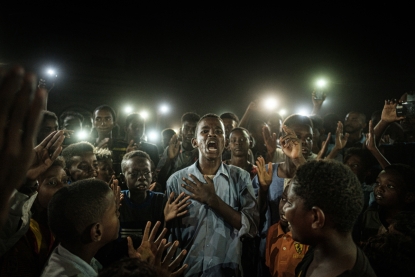 People chant slogans as a young man recites a poem, illuminated by mobile phones, before the opposition's direct dialog with people in Khartoum on June 19, 2019. (AFP / Yasuyoshi Chiba)
People chant slogans as a young man recites a poem, illuminated by mobile phones, before the opposition's direct dialog with people in Khartoum on June 19, 2019. (AFP / Yasuyoshi Chiba)One of the reasons I like being a photographer is because I can go to new places.
When I applied for my visa to go to Sudan, I was very excited -- not only would it be my first time in the country, but it was at the time in the news, with thousands of protesters holding a peaceful sit-in.
The unrest started after the government tripled the price of bread. The army overthrew the longtime president, but the protesters kept holding a sit-in at the entrance of the army headquarters, demanding civilian rule. Then an unknown military group dispersed them. Doctors linked to the protest movement said at least 128 people died in the violence; while the authorities gave a death toll of at least 87 and denied ordering the dispersal.
I arrived in Khartoum about two weeks later. The protesters had disappeared from the streets, but the security forces were everywhere. The internet had been shut off and people were not able to share information through social networks.
One night, my colleagues and I went to a residential area where opposition leaders were supposed to meet with supporters for a briefing.
The place was in a total blackout. As organizers prepared generators, youth collected rocks to barricade the streets leading to the site.
Then all of a sudden people started clapping their hands in the dark. They held up their mobile phones to illuminate a young man in the center.
He was reciting something, as people around him shouted “thawra.” Later a colleague told me that the young man was reciting a famous poem and that the others were shouting “revolution.”
Though I could not understand him at the time, his facial expression and voice impressed me. I could not stop focusing on him to capture the moment. I didn’t name him, as I was a bit nervous about the protesters’ security.
During my stay, I felt like there was always someone watching me. I was also watched over -- people were always inviting me in for tea, coffee, a bottle of water.
We face a lot of uncertain obstacles, especially working in Africa, but, on the other hand, we encounter unexpected generous moments that compensate for all the difficulties.
Sometimes when I work, I feel like I am recording history. I can only hope that each image can be a message for a better future.
I like being a photographer since all of my experiences in different parts of the world come together to create a new perception. And this is what motivates me to keep going.
Nicolas Asfouri
1st prize, General News, Stories


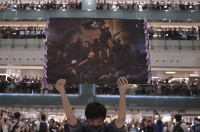
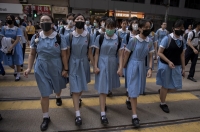
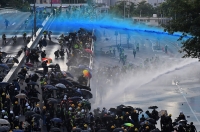
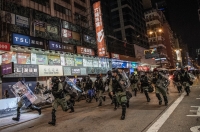
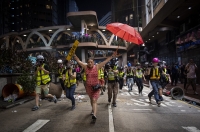
I decided to quit photographing war after my friend Sardar Ahmad, a journalist in AFP's Kabul bureau, was killed in an attack in 2014. His death touched me deeply. Maybe it’s time to stop shooting war, I told myself.
You could say that I was born into war, coming into the world as I did in Beirut, the epicenter of a conflict that tore apart my family and the country.
In 2004, I went to Iraq on my first assignment as a war photographer. But 10 years later, when Sardar died, I decided I had had enough. It was time for a change. So since then, I’ve been concentrating on human rights and poverty. Through my images, I want to give a voice to those who come out for their rights, to show their struggle.
In Hong Kong, I covered the “umbrella movement” in 2014. The demonstrations that erupted in 2019 were very different. The protesters were even younger. You saw a lot of students, as young as middle schoolers. This time around the protests were much more organized and also more radical.
AFP photographers covered the movement right from the beginning, all the aspects, all the angles. The team was out in the streets day and night.
When I work, sometimes I concentrate on the task at hand so much that it’s almost like I’m in a state of meditation. Especially when it gets tense. I don’t want to miss a crucial moment.
One of my favorite images is of the protester on the ground, with the policeman’s knee on his neck. I had seen the demonstrator, wearing glasses, in the moments before. His arrest was so violent that I was sure that the glasses had been broken. But when I looked at the images afterward, I saw that his glasses were intact and that Hong Kong's skyline was reflected in the lenses. Which made the picture even more powerful. You could recognize Hong Kong in those glasses.
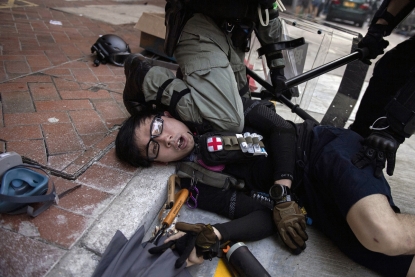 Hong Kong police detain a protester (C) during demonstrations in the Wanchai district in Hong Kong on October 1, 2019, as the city observes the National Day holiday to mark the 70th anniversary of communist China's founding. (AFP / Nicolas Asfouri)
Hong Kong police detain a protester (C) during demonstrations in the Wanchai district in Hong Kong on October 1, 2019, as the city observes the National Day holiday to mark the 70th anniversary of communist China's founding. (AFP / Nicolas Asfouri)Another one of my favorites is that of a young woman holding the hand of a young man whom the police were knocking to the ground. They were two teenagers really, brutally thrown to the ground by the police. From what I could tell, their only sin was wearing masks. The scene lasted probably a few seconds -- if I hadn’t been as focused as I was I would have probably missed it. To me, that image really summed up the protesters’ slogan -- “come together, leave together.”
She just wouldn’t let go of his hand. It really showed how determined these young people were.
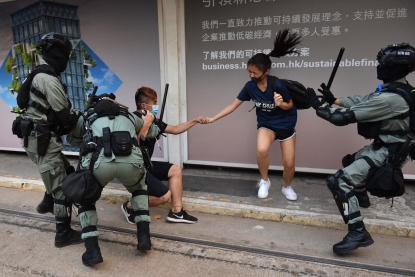 Hong Kong police chase down a couple wearing facemasks in the Central district in Hong Kong on October 5, 2019, a day after the city's leader outlawed face coverings at protests invoking colonial-era emergency powers not used for half a century. (AFP / Nicolas Asfouri)
Hong Kong police chase down a couple wearing facemasks in the Central district in Hong Kong on October 5, 2019, a day after the city's leader outlawed face coverings at protests invoking colonial-era emergency powers not used for half a century. (AFP / Nicolas Asfouri)And then there is the image of a group of young people encircled by police after they had left the grounds of the polytechnic university after a week inside. You see on their faces how tired they were. Exhausted. They ran out, an officer screamed “Stop or I’ll shoot” twice, and they put their hands up.
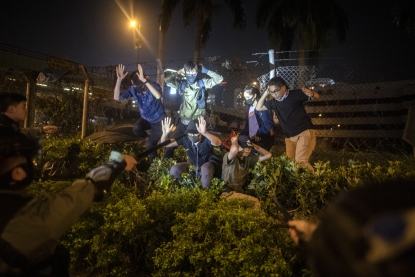 Police detain protesters and students after they tried to flee outside the Hong Kong Polytechnic University campus in the Hung Hom district of Hong Kong on November 19, 2019. (AFP / Nicolas Asfouri)
Police detain protesters and students after they tried to flee outside the Hong Kong Polytechnic University campus in the Hung Hom district of Hong Kong on November 19, 2019. (AFP / Nicolas Asfouri)I would like to know where these people are today. It would be interesting to see if the movement gets a second wind. What’s important to me is that these images will be seen around the world, helping to understand the situation of those I photographed.
Sean Davey
2nd prize, Contemporary Issues, Singles
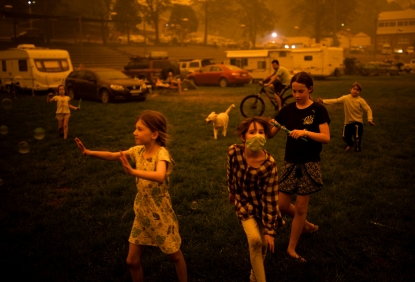 Children play at the showgrounds in the southern New South Wales town of Bega where they are camping after being evacuated from nearby sites affected by bushfires on December 31, 2019. (AFP / Sean Davey)
Children play at the showgrounds in the southern New South Wales town of Bega where they are camping after being evacuated from nearby sites affected by bushfires on December 31, 2019. (AFP / Sean Davey)On December 31, 2019 news spread that massive fires had impacted towns on the south coast of New South Wales. Living three hours away in Canberra, and with my car already prepared for covering the ongoing bushfire crisis, I made my way to Bega and arrived in the late afternoon.
Many roads were closed due to the bushfire, and large parts of the south coast were completely cut off with no electricity, fuel or water. Even getting there was an arduous journey.
Locals and tourists alike had been evacuated to the Bega Showgrounds for safety as the fires were still ongoing and there was great fear that other towns would be impacted. It would not be an exaggeration to say that the situation was chaotic.
When I arrived I saw hundreds, if not over a thousand people camped with their tents and caravans set up. The smoke was thick, turning day to night with a strong orange glow. Many people wore face masks to protect themselves from the smoke and there was little to no access to information about what was happening. Many people were asking where I came from and how I got there, evidently weighing up how they could possibly themselves and their families to safety.
I saw a group of children playing in the middle of the showgrounds, and made my way to them. I approached a woman whose daughter was in the group, and asked how she was, identifying myself as a photographer. Her name was Kath Ferris and her daughter Abigail is the young girl in the face mask in the picture.
Kath and her family were also from Canberra. They had evacuated to the showgrounds from a nearby campsite. They were on their way to visit family in a nearby town of Candello.
The children appeared to be very happy, and in that microcosm, the gravity of the surrounding situation seemed suspended by their innocence.
I knew there was a strong picture to be made in this situation, and looking through the camera’s viewfinder, I saw the scene as a photograph, as well as being there in real life. When I get this feeling with photography, it is like a type of time travel, very surreal, and it is something that only happens very rarely. When I reviewed my pictures from that afternoon to send to the desk, I knew this picture would be the one, even though I sent two variations of the same scene. The surreal quality I felt when making the image is still there when I look at it today.
It is undeniably a great professional honour to be recognised by the jury of World Press Photo. But in the context of what so many people had gone through that summer, it is also bittersweet to celebrate such an achievement.
Oli Scarff
3rd prize, Sports, Singles
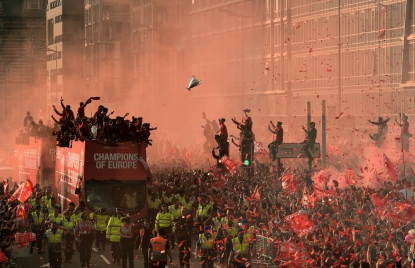 Football fans line the streets to see the Liverpool football team take part in an open-top bus parade around Liverpool, north-west England on June 2, 2019, after winning they won the UEFA Champions League final football match between Liverpool and Tottenham. (AFP / Oli Scarff)
Football fans line the streets to see the Liverpool football team take part in an open-top bus parade around Liverpool, north-west England on June 2, 2019, after winning they won the UEFA Champions League final football match between Liverpool and Tottenham. (AFP / Oli Scarff)Even before the 2019 Champions League final, I'd asked some fellow photographers about the prospect of an open-top bus victory parade. The ones who'd covered the parade following LFC's triumph in 2005 told me to expect crowds like I've never witnessed before.
They weren’t wrong. The sheer number of fans lining the 17km was unbelievable, police estimated there to have been 750,000 and it felt like the whole city (well, the red half at least) had come out to share in the team's triumph. The effort to which the spectators went to get a good view was also impressive -- no road sign or traffic light went unclimbed in pursuit of an unobstructed view and an opportunity to be closer to their heroes. At one point a man very athletically climbed a completely smooth lamppost to the height of the top deck of the passing bus, cheered, and then promptly slid back down.
I, along with numerous other press photographers and videographers, was stationed on the media bus that was travelling just ahead of the players' bus for the whole route. One of the main challenges for me photographically was the requirement to only spend 5 minutes at a time at the rear of our bus on a rotation system to accommodate everyone. Another was that, despite a protest from the club photographer, LFC had positioned a large yellow truck between the media bus and the players' bus that would periodically eject huge clouds of red confetti into the crowd from several big cannons. This created a great atmosphere but whenever it occurred, and it did so frequently, it completely obscured our view of the players. My photo that features in the World Press Photo Awards this year was taken towards the end of the long parade when the crowds were at their greatest and red smoke grenades were being let off all around. Amidst the cheering a single helium-filled balloon in the shape of the Champions League trophy drifted poignantly across the scene.
I've wanted to be a photographer since I was about 14 years old and my dad showed me how to use a camera. He was a photographer before running his own photo printing business and he passed on his passion and expertise to me. I find photography to be creative, technical, endlessly challenging and something I've always had a real love for. The approach I take to my work, if it's possible to define such a thing, is to remain very observant to my surroundings - to be constantly alert to changes in my subject matter and the light, whilst also being aware of the story I'm covering and how best to illustrate that at any moment.
Editing by Yana Dlugy in Paris.







